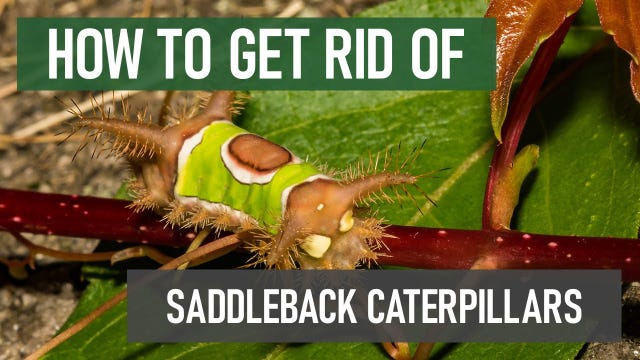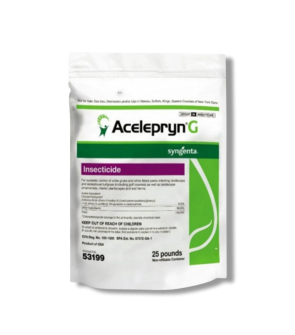Gain access to personalized product screening, the best pricing, rewards, and more!
Most Effective Products
Saddleback Caterpillar Control: How To Get Rid of Saddleback Caterpillars
This page is a general saddleback caterpillar control guide. Using the products and methods suggested, you will get control of saddleback caterpillars. Follow this guide and use the recommended products, and we guarantee 100% control over saddleback caterpillars.
If you're a homeowner and avid gardener, you might have stumbled upon a saddleback caterpillar. This insect is mainly brown and green and has a back mark resembling a saddle. While the average caterpillar has few harmless and superficial spines on its body, the saddleback caterpillar has spikes that can sting. These caterpillars are found throughout the eastern United States, from Florida to New York, and as far west as Texas, Indiana, and Kansas.
These hairs are mainly self-defense. They can prick the skin and release poison to anyone who dares touch the saddleback caterpillar. Usually, a homeowner gardening outdoors will encounter a saddleback caterpillar and get stung by its hair while picking up leaves.
Saddleback caterpillars are covered with venomous, spiky brown spines, which can cause pain and swelling if they sting you. While a saddleback sting can't kill you, there are some additional side effects from a sting, such as nausea.
Saddleback caterpillars are dangerous because with a single touch of one of their spines, you will receive a powerful sting greater than a bee or wasp sting and, in many cases, cause severe allergic reactions that need professional medical attention.
If these stinging caterpillars have become a problem in and around your home, our DIY guide below has the solution to ensure it’ll be the last rodeo for those saddleback caterpillars.
Identification
Before you can proceed with treatment, you must be sure that the pest you are dealing with is a saddleback caterpillar and not some other insect. Misidentification can lead to using the wrong treatment methods and products, which can end up being a waste of time and money. Here are some identifying characteristics of saddleback caterpillars:

- Saddleback caterpillars are sluglike caterpillars that appear two-headed due to it's venomous spines (tubercles) on the front and rear of it's body, as well as smaller spikes along the side that release potent venom. Its short, stubby legs and hidden prolegs give it a smooth, slug-like appearance.
- Fully grown, these caterpillars reach about 3/4 to 1 inch in length. Their coloration serves as a warning to predators: the front and rear ends are dark brown, while the middle portion of the back is bright green with a large central brown patch resembling a saddle and bordered with pale markings. Additionally, the rear end bears pale spots that resemble a face, likely to confuse or deter attackers.
- Saddleback caterpillar eggs are yellow and somewhat transparent, and measure 1.2 to 2.0 mm in length and about 1 mm in width. These eggs are laid on the upper surfaces of host plant leaves, usually in irregular overlapping clusters containing a large deposit of eggs.
- The saddleback caterpillar transforms into the saddleback caterpillar moth. As a moth, its body and wings are covered in dense scales, giving it a fuzzy or furry look. It has dark brown forewings, accented with cinnamon patches and small white spots. In contrast, the hindwings are lighter brown. Females are typically larger than the males, with a wingspan ranging from 1.0 to 1.7 inches.
Use the description above to help you properly identify the saddleback caterpillar on your property. If you are unsure, contact us; we will try to help you get the correct identification.
Inspection
Once you have confirmed that you are dealing with saddleback caterpillars, you must inspect them to find out where they are feeding and what attracts them to the area. When doing the inspection, make sure to wear gloves and long clothing and use a stick to search around bushes and plants.

Where To Inspect
Saddleback caterpillars are solitary feeders that consume the leaves from various trees, shrubs, wildflowers, and crops.
They can be seen especially on apple, basswood, cherry, chestnut, dogwood, elm, maple, oak, plum, grapes, citrus, sunflowers, viburnums, and many others, with over 40 plant families reported as suitable for feeding for this pest.
What To Look For
Despite their broad diet, they generally cause little damage to plants, with the main risk being accidental contact with their stinging spines.
They primarily consume the leaf tissue between veins, resulting in irregular holes or ragged edges, and in some cases may skeletonize parts of the leaf, leaving only the veins intact. Their feeding patterns are scattered rather than uniform, so only portions of a plant are affected at a time.
Treatment
Once you have confirmed saddleback caterpillar activity, you will begin treatment. Remember to read all product labels, follow the application instructions on them, and wear personal protective equipment to stay safe.
Saddleback caterpillars are most active during the warmer months of the year, typically from late spring to early fall. Larvae are commonly seen feeding on host plants from May to September.
From July to early October, adult moths are expected to breed and lay eggs so we recommend timing applications around this time to better prevent caterpillar activity.
Our top recommendation is Supreme IT Insecticide for controlling leaf-feeding caterpillars like saddleback caterpillars. This bifenthrin-based insecticide concentrate will control and repel up to 70 pests. Once dried, it will create a 90-day residual barrier to keep pests away from treated areas.
Step 1: Measure and Mix Supreme IT in a Sprayer

Determine how much Supreme IT to use by measuring the square footage of the treatment area. Find the square footage by measuring the treamtent area's length and width in feet, then multiply them together (length X width = square footage).
According to the label, to treat saddleback caterpillars, you must mix 0.125 to 1.0 fl. oz. of Supreme IT with a gallon of water to treat 1,000 square feet.
For perimeter treatment around your home, use 1 fl. oz. of Supreme IT per 1 gallon of water per 1,000 sq. ft.
You will need to mix with water in a handheld pump sprayer, backpack sprayer, or hose-end sprayer.
Fill your sprayer halfway with the required amount of water, and then add the appropriate measured amount of Supreme IT based on your calculations. Fill with the remaining half of the required amount of water, close the sprayer lid, and agitate the sprayer until the solution is well mixed. You are now ready to spray.
Step 2: Apply Supreme IT
 Begin by spraying the top and bottom of plant leaves until wet, but not to the point of runoff.
Begin by spraying the top and bottom of plant leaves until wet, but not to the point of runoff.
Spray around the perimeter of your structure. Apply 3 feet up and 3 feet out from the foundation's walls. Spray in this manner all around the foundation of your structure, making sure to contact window frames, door frames, cracks, and crevices.
Next, you will spray the whole yard via fan spray to get uniform coverage. Spray your whole lawn, starting from the back to the front. Also, spray ornamentals and landscaping, focusing only on non-edible vegetation areas. Do not spray fruit-bearing trees or flower beds.
Do not allow people or pets to enter the treated areas until the spray dries.
Prevention
After eliminating the saddleback caterpillars, you need to make sure they don't make a return by implementing some preventative measures. Here are the following measures we suggest taking:
- Start by avoiding planting the species of plants and trees that saddleback caterpillars feed on. Avoid planting apple, basswood, cherry, dogwood, elm, maple, oak, or plum trees if possible.
- Pruning branches can be an effective part of preventing and managing saddleback caterpillars. By removing heavily infested or damaged branches, you physically eliminate clusters of eggs, young larvae, and feeding sites, reducing the population on the plant. It also improves air circulation and sunlight penetration, making the environment less favorable for caterpillar development.
- Altering lighting can help reduce adult saddleback caterpillar moth activity, as these moths are nocturnal and attracted to artificial lights. By minimizing bright outdoor lights near host plants or using yellow “bug lights” instead of standard white lights, you can make the area less attractive to adult moths, which may help reduce mating and egg-laying nearby.
- It would be best to spray Supreme IT every three months around the perimeter of your structure and broadcast treatment to keep saddleback caterpillars away. This maintenance treatment will help prevent future infestations.
Key Takeaways
What are Saddleback Caterpillars?
- Saddleback caterpillars are distinctive caterpillars known to frequent gardens and deliver a poisonous sting when touched.
How to Get Rid of Saddleback Caterpillars
- Our top recommendation for treating saddleback caterpillars is Supreme IT Insecticide. Apply it around your home perimeter and to your lawn and ornamental plants where saddleback caterpillars may be active or hiding.
Preventing Saddleback Caterpillar
- Preventative applications of Supreme IT around your yard and home perimeter will make it unlikely that the saddleback caterpillar infests again. Be sure to also maintain regular watering, plant care, and turning off lights or changing bulbs to prevent adult activity.










